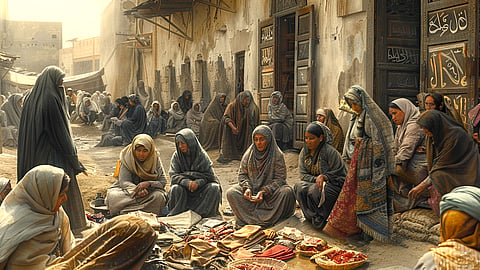- Commentary
- History Vignettes
- Notes on Culture
- Dispatches
- Podcasts
- Indian LanguagesIndian Languages
- Support

FROM THE OTHER SIDE of the house comes the murmur of the noisy street, and the Muhammadan woman is drawn to the venetianed windows to look down upon the turbans of the Muhammadan men passing by; and on the roofs of the jutkas and bullock-carts in the roadway. The people are all strangers to her and the scene soon grows monotonous. She turns back to her own narrow horizon where the births, deaths and marriages have an absorbing interest.
However secluded her life may be, it is not spent in idleness. If she is the wife of a tailor or clerk, she passes long hours embroidering muslin with cheap cotton. She gets very little for it as she is obliged to take what the merchant offers. The money helps to buy a piece of bright-coloured satin, which is made up into a pair of pyjamas for her little girl, such as the child wears who is seated on a chair.
If she is the wife of a rich merchant, nothing will induce her to touch a needle. In India there is no honour in labour; and it is an understood thing that only those who are obliged, do manual work. The merchant’s wife has no obligation to earn, and she is able to live in idleness; not a dreamy somnolent idleness by any means, but an unprofitable life of gossip, intrigue, squabble and self-indulgence. Her time is fully employed, although her long fingers never touch needle or book.
The most interesting event in a Muslim woman’s life whatever her condition may be is marriage, her own or a relative’s. Next in interest is a birth or death ; but neither of these has as many ceremonies connected with it as marriage.
The daily round—the preparation of food, the treatment of ailments, the observation of omens, and the lengthy toilet—fills the day. She does not ask for anything different. Born and brought up to it, she has no wish to alter her circumstances. The cry is raised outside the harem for emancipation, for a lifting of the curtain; but it finds little echo in the heart of the gosha woman. To bring her out without a very gradual preparation would upset all her ideas of propriety; would outrage her sense of decency. The disgrace of liberty would outweigh any pleasure that she might feel on seeing the outside world. After the ultra-retired life, she would be confused and at a complete loss to know how to behave in public.
Worse still would be the attitude of the outer world towards her. The Muhammadan has no time-honoured public opinion founded on chivalry, such as underlies European society, to guide him in his conduct towards women. He would show his disapproval of her appearance unveiled by adopting a rude rough manner, such as the lower class of European would exhibit in his behaviour towards one of his own women who had put on masculine dress.
It is the mark of respectability to be gosha, and it is the ambition of every Muhammadan woman to attain to it. The wife of the head gardener at Government House, Ootacamund, a man who was neither rich nor in a high position, admitted that she had never seen the garden where her husband had worked for many years, although she had lived close to it all her life, so great was her fear of breaking her gosha and thus “ losing caste ” in the eyes of her neighbours.
The Muhammadans marry young, but not as young as the Hindus. The man is usually eighteen before he is given a wife; the girl is about fourteen. The bride and bridegroom are not consulted in the choice which is made for them by their parents. As a rule, they do not see each other till the day when they begin their honeymoon. Up to that time they have to take each other in faith. They listen on both sides to glowing descriptions overdrawn and exaggerated, and are assured again and again that Allah has been good, and that each has won a prize in the lottery of marriage. The girl longs for youth; the man for beauty—he is sure of youth and need not trouble himself on that score. How often bitter disappointment enters their lives can only be conjectured. The harem knows how to keep its secrets.
Since the young people are not allowed to choose for themselves, there must of necessity be a third person to bring them together. This is usually an old woman of the lower and poorer class who follows the trade of pedlar. She is a privileged person, a link between the outer world and the harem, and she is warmly welcomed by the gosha women. In addition to bringing her wares for sale, she is the purveyor of gossip of all kinds.
To be continued
The Dharma Dispatch is now available on Telegram! For original and insightful narratives on Indian Culture and History, subscribe to us on Telegram.
